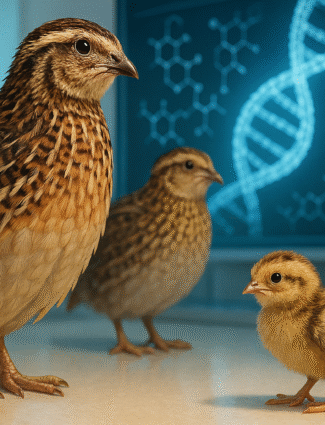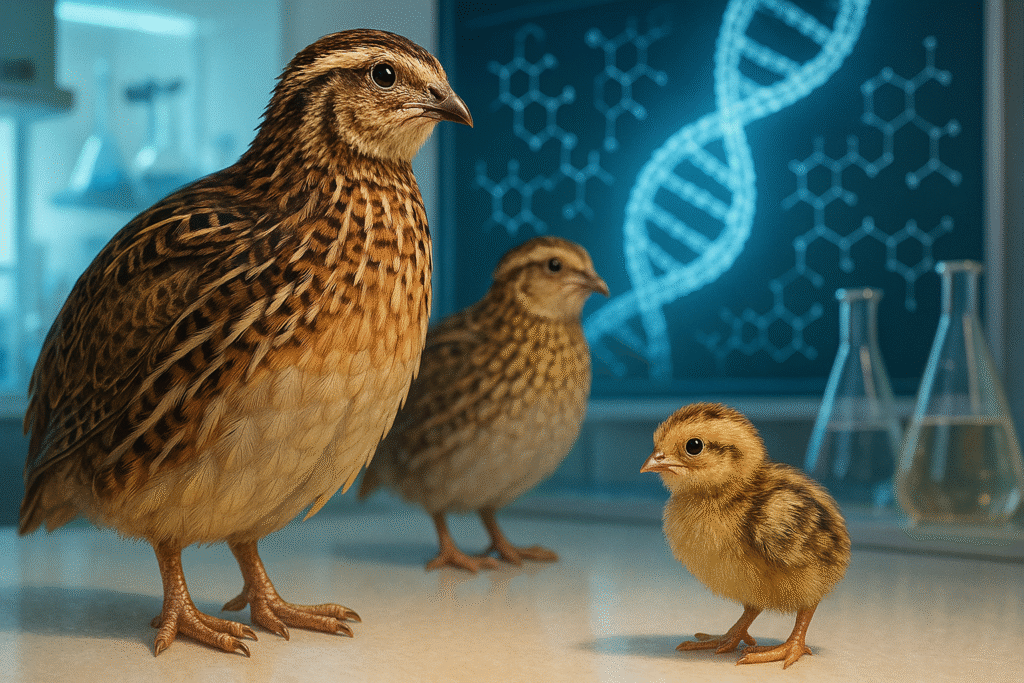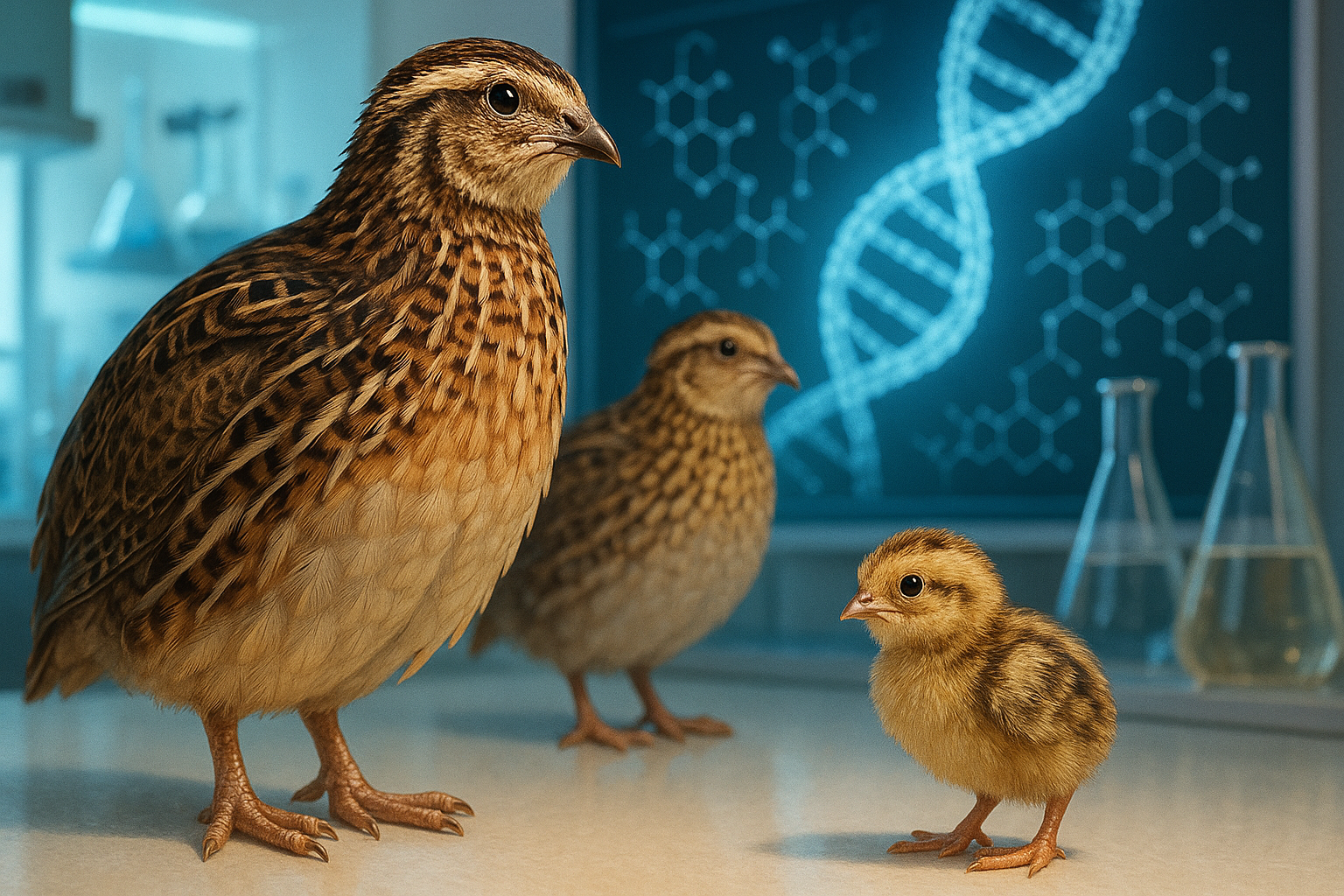
GENETIC STUDY OF EXAN 3 AND 4 OF INSULIN LIKE GROWTH FACTOR-2 GENE (IGF2) AND ITS EFFECT ON GROWTH TRAITS IN JAPANESE QUAIL
Estimated reading time: 10 minutes, 19 secondsAbstract
The pituitary gland releases insulin-like growth hormone (IGF) to promote cell division and stimulate the proliferation of myoblasts, which subsequently enhances skeletal muscle growth in an individual. Among the genes involved in this growth process, IGF1 and IGF2 play pivotal roles.
As the activity of these IGFs increases, so does the overall growth of the organism. The mechanism underlying this process is complex, as IGF1 and IGF2 interact with various receptors, including the insulin-like growth factor 2 receptor (IGF2R), as well as binding proteins.

Photorealistic illustration of Japanese quails in a modern research laboratory
For the study of the IGF2 gene’s effects, the Japanese quail (Coturnix japonica) was selected as the model organism. In this experiment, measurements were taken from 50 quails, including their length, width, weight, wing span, drumstick length and circumference, as well as shank length and diameter.
Blood samples of 1 ml were collected from each quail and stored for analysis. For DNA extraction, 200 µl of blood from each sample was processed using an adapted version of the conventional organic extraction method. The third coding sequence of the IGF2 gene revealed four transition mutations, while the fourth coding sequence exhibited ten transition mutations and two transversion mutations. This research contributes to advancing our understanding of quail genomics and provides valuable insights into the genetic underpinnings of growth.
The poultry industry is the one that is expanding the quickest of all livestock. Due to the fact that it is the human body’s primary source of protein, it was estimated that one billion people are employed in that field. Because its manure enriches the soil with nutrients, it is essential to plant growth.
The demand for Gallus Gallus (chicken) was estimated to have increased over the past few years. According to Bingham (2006), the chicken does not contain the trans-fats that are linked to heart disease and only has about 5 grams of fat per 100 grams. According to Sparks (2006), the hen’s egg plays a significant role in balancing human nutrition. Because per capita demand for chicken is steadily rising, researchers have begun looking into other birds to alleviate this burden. Quail birds will therefore be an excellent choice (Fig. 1.1).
The skeletal muscles are made up of fibers from muscles, connective tissues, and adipose tissues. Important parameters that were observed included technological, nutritional, and sensory aspects of meat from various livestock and fish species.
The color, tenderness, juiciness, flavor, and other characteristics of meat depend heavily on the amount and composition of intramuscular fat. These parameters, which can be controlled by genetics or environmental factors to increase meat production efficiency (List rat et al., 2016).
Breeding of Japanese Quail
Japanese quail selective breeding began in the 1900s, and in 1940, the quail’s eggs sparked a significant industry shift. Similar to chicken, Japanese quail eggs contain nutrients and benefits. The Japanese quail’s eggs average 10 grams (Fig. 1.3).According to (Hubrecht & Kirkwood, 2010) the majority of the Japanese quail breeds were eradicated during World War II, leaving only a few surviving lines that are currently flourishing.
In 1957, biomedical research on Japanese quail was taken up by Auburn University and the University of California. The Japanese quail’s genetic work in genetics, nutrition, physiology, pathology, embryology, cancer, behavior, and the toxicity of pesticides was then initiated (Ainsworth, Stanley, & Evans, 2010).
Systematics
A genetic test revealed that, with the exception of B30 and tRNA, the majority of Gallus gallus and Coturnix japonica have the same fundamental set of gene family members. The genetics of the NK gene clearly showed that both species have been closely related in the past (Shiina, 2004). Because it takes only 114 to 120 days for the eggs to hatch, Bangladesh, like many other Asian nations, is an excellent location for quail farming.
According to (Kabir2013), a blood sample was analyzed and it’s hematological and biochemical contents, such as calcium and glucose, indicated that quail eggs and quail meat were found to be very nutritious and healthy for humans.
Game Bird
In Bangladesh, the quail was introduced as a hobby bird as a game bird in 1980 (Fig. 1.4).The importance of quail poultry grew, and people started to be very interested in commercial quail production. Eggs and meat were first produced commercially in Japan and Europe, respectively. According to F. Minvielle, E. Hirigoyen, and M. Boulay (1999), quail became a popular meat and egg source in Bangladesh.
Role of insulin like growth factors-2 (IGF2)
Somatomedin is another name for insulin-like growth hormone. When a person needs to grow, the pituitary growth hormone uses IGFs to start cell division. IGF1 and IGF2 are two molecules that play a significant role in the growth pf cartilage (Salmon & Daughaday, 1957). Insulin-like growth factors are made up of the IGF1 and IGF2 genes. As the activity of IGFs rises, so does the organism’s growth. Because of its structural similarity to insulin, it was given the name “insulin-like growth factors” (Rinderknecht & Humbel, 1978a, 1978b).
It significantly increases cell division for the purposes of living organism growth, migration, and differentiation. Because IGF1 and IGF2 cooperate with a variety of receptors, such as the insulin-like factor 2 Receptor (IGF2R), as well as binding proteins, the mechanism is intricate. IGF2R shares structural similarities with mannose-6-phosphate (M6P). Plasma can be traced for both IGF1 and IGF2. It was also anticipated that IGF1 would have high activity from birth through puberty, whereas IGF2 would have high activity during prenatal development (Sara et al., 1983).
By stimulating myoblast proliferation, muscle fiber differentiation, and increase in size, insulin-like growth factors play an important role in skeletal muscle growth. According to Bass, Oldham, Sharma, & Kambadur (1999), the size of the muscle mass increases in hypertrophied muscle cattle breeds due to differences in the myostatin mutation and MyoD expression in the muscle. IGF2 plays a crucial role in the growth of the birds.
Methodological steps include sample collection, DNA extraction, primer design, polymerase chain reaction (PCR), and IGF2 gene sequencing to compare the genetic makeup of quail birds with higher body weight to those with lower body weight. IGF2, which has only recently been characterized and is controlled by differential expression of IGF-binding proteins and receptors, is the most significant regulated factor. According to Chao & D’Amore (2008), the over expression of the IGF2 gene has been linked to a variety of diseases.
Two alleles, one from each parent, are carried by organisms. Studies on genomic imprinting suggested that an organism inherits traits from both parents, but in the case of human IGF-II, only the paternal allelic copy of the gene is active and the maternal copy does not. The mutation in the IGF2 gene was linked to a wide variety of cancers (Eggermann, 2009). The IGF-II gene provides the instructions for the synthesis of insulin-like growth factor-II protein.
According to Bergman, Halje, Nordin, & Engstrom (2013), the activity of the IGF-II gene was found to be extremely high during the fetus’s development and to decrease after birth. According to Florini, Ewton, & Coolican (1996), growth hormone (GH) is responsible for activating the liver to initiate the production of insulin-like growth factors (IGFs) and insulin-like growth factor protein 3 (IGFBP3), which play a significant role in regulating the growth and differentiation of skeletal muscles.
Although IGF1 and IGF2 play identical roles in the metabolic activities and growth of living organisms, numerous distinct differences were also observed when the research was carried out in vivo (Engstrom et al., 1998).
Insulin-like growth factor binding proteins, or IGFBPs, are made up of about six distinct designs found in living things. Because they were required to perform a particular function during development, these proteins were active. According to Clemmons et al. (1997), in vitro research revealed that when biologically active IGFs were unavailable, IGFBPs lost their ability to function (Clemmons, 1997). During the cross between parent chicken stock and four Thai breeds, the roles of chicken growth hormone and insulin-like growth factor (IGF) were investigated.
According to Anh, Kunhareang, & Duangjinda (2015), allele G plays a significant role in the average daily weight gain of chickens, and IGF also plays a significant role in increasing body mass by promoting the growth of breast muscles and wings. F-Statistics (FST), which is used to evaluate studies of SNP-wise genetic differentiation between chicken populations, is the most useful fixation index.
Three 600K SNP-chips were used to genotype 96 individuals from 14 non-commercial fancy breeds and three commercial layer breeds. POMC, PRKAB2, SSP1, IGF2, CAPN1, TGFb2, and IGFBP2 were the genes involved in the breeds’ growth (Gholami et al.,) which are important for reproductive traits.2014).IGF2 plays a crucial role in the birds’ growth.
The 50 quail will be measured for their length, width, weight, expanded wings, drum stick length and circumference, shank length, and diameter. The samples were divided into two groups: Japanese quail of lower weight and higher weight. Each sample’s 1 ml of blood will be taken and stored in the refrigerator. According to Sambrook & Russell (2006), the conventional organic method would be used for the DNA extraction, with some modifications, from the 200 l of blood from the 50 samples.
The IGF system’s pleiotropic effects on mammalian growth and development were investigated. The class aves’ IGF system’s physiology is identical to that of other species. The free form of the IGF system was found to be abundant in chicken, and its biological metabolic responses differed from those of humans. The etiological study of diseases and the factors that promote poultry growth are more important than ever (McMurtry & Brocht, 1997).
Growth regulators
The growth and development of skeletal muscles are coordinated by insulin-like growth factors (IGFs), but their determination is crucial due to the fact that IGFs are produced by multiple tissues. According to Barton et al., deletion of GRP94 resulted in a 30% decrease in body and muscle growth.2012).When chicken males and quail males were crossed in an experiment to create hybrids, it was found that only 5.4% of the eggs produced were fertile and that there was no hatching (Mitsumoto & Nishida, 1958).
Growth hormone and growth hormone receptor research contributed significantly to our understanding of sex-linked dwarfism in chicken. According to Luo, Lin, Li, Nie, & Zhang (2016), the molecular mechanism has opened up a new era for identifying the various genes, such as those involved in the MAPK, P13K-Akt, Wnt, and Insulin signaling pathways, as well as the miRNA, that cause chickens to develop dwarfism from the embryonic stage to seven weeks of age.
Growth inhibitors
The growth hormone receptor gene mutation was the cause of the sex-linked dwarf chicken’s lower body weight, smaller muscle fiber diameter, and fewer muscle fibers. According to Lin et al., lower-body-weight chickens had elevated levels of let-7b, which resulted in decreased production of insulin-like factor 2 mRNA binding protein 3 (IGF2BP3) and decreased growth.2017).In the avian species, growth regulators like insulin-like growth factors I and II were essential for muscle development.
The growth of the skeleton may be slowed down by inhibitors like myostatin. It was discovered that the translational mechanisms of IGF1 and IGF2 increased muscle growth when myostatin expression was altered. The growth of skeletal muscles is aided by insulin-like growth factors (IGFs), but their selection is crucial due to the fact that IGFs are produced by a variety of tissues. GPR94 (glucose-regulated protein 94) was examined for normal muscle growth in murine striated muscles. According to Barton et al., deletion of GRP94 resulted in a 30% decrease in body and muscle growth.2012).
GENETIC STUDY OF EXON 3 AND 4 OF INSULIN-LIKE GROWTH FACTOR-2 GENE (IGF2) AND ITS EFFECT ON GROWTH TRAITS IN JAPANESE QUAIL
Have you been searching for professional guidance on complex genetic and molecular biology research? Whether it’s dissertation writing, thesis development, or preparing a research paper for publication, Qundeel.com is here to help.
Our expert PhD researchers specialize in life sciences, biotechnology, and agricultural genetics. If you are working on a dissertation such as “Genetic Study of Exon 3 and 4 of Insulin-Like Growth Factor-2 Gene (IGF2) and Its Effect on Growth Traits in Japanese Quail”, we can assist you in crafting a high-quality, plagiarism-free, and publication-ready manuscript tailored to your academic requirements.
So, why are you waiting? Hire a Qundeel.com writer today and experience top-notch support for:
-
Complete thesis writing
-
Research paper development for indexed journals
-
Publication support in Scopus, Web of Science, and Q1 journals
✨ Your research deserves recognition. Don’t let it go unnoticed. ✨
🔴 [Get My Dissertation & Thesis Done by Experts at Qundeel.com] 🔴
At Qundeel.com, we provide end-to-end dissertation and thesis writing services, tailored specifically for PhD and Master’s students. Our professional writers and subject specialists ensure that your work is:
100% original and plagiarism-free
Written in a scholarly tone that passes Turnitin and AI detection
Structured to meet international university standards
Backed with valid references and strong analysis
Ready for publication in high-ranking journals
🌟 Stop delaying your success. Let Qundeel.com handle your research project today! 🌟

